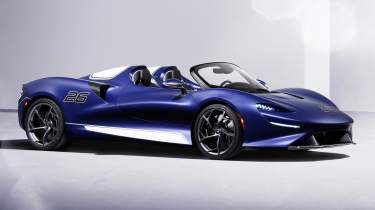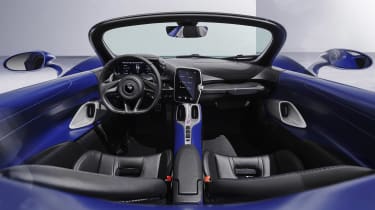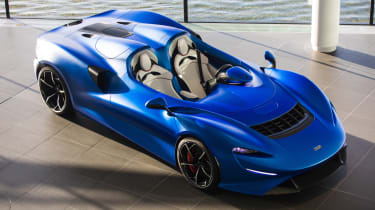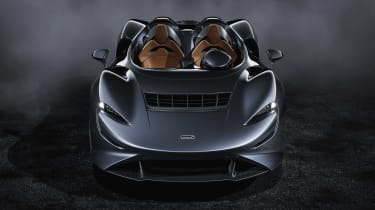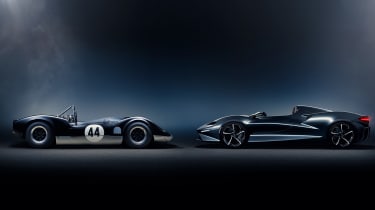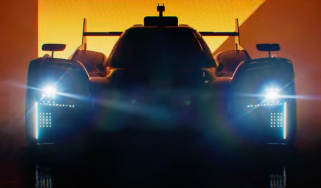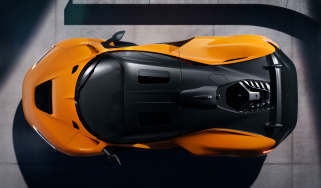McLaren Elva now available with windscreen – total production run reduced to just 149 units
The £1.4m McLaren Elva can now be optioned with a traditional windscreen, and production numbers have again been slashed, to just 149 units
McLaren has revealed more details about the optional windscreen available on its open-top Elva speedster, a component designed to meet legal requirements in some US states, and an element that will dramatically increase its day-to-day usability for owners. This first model has been revealed in a heritage-liveried Satin Casa Blue, with deliveries of customer cars to commence towards the end of 2021.
As well as making it more usable on-road, the windscreen-equipped Elva does without the standard car’s Active Air Management System, yet thanks to lightweight glass and a carbonfibre frame, only adds 20kg to the total weight. This is despite the inclusion of rain-sensing wipers, washer jets, sun visors and heated glass.
The Elva remains otherwise unchanged, still lacking a roof, side windows or rear screen for that full speedster experience.
> First Lanzante LM 25 Editions delivered – conversion references McLaren F1 GTR-1R
The firm also quietly announced a second reduction in Elva production numbers, slashing the figure from 249 to just 149 overall – this represents a 250-unit reduction over the initial planned production of 399. It joins the P1, Senna and aforementioned Speedtail in McLaren’s Ultimate Series, topping the contemporary McLaren range. The Elva’s name is derived from Bruce McLaren’s exploits in customer sportscar racing in the 1970s, when Elva manufactured and supported a customer racing version of McLaren’s dominant M1A.
The core technical ingredients are familiar, but where the Senna was designed to be track-focused, and the Speedtail all about top speed, the Elva has been designed specifically for the open road – presumably on a sunny day.
Production is already underway, with first deliveries of cars equipped with the windscreen scheduled for late-2021.
What is the Active Air Management System?
In simple terms it comprises a carbonfibre panel in what would be the front bonnet that opens above a certain speed. This exposes a vent which is fed air from an inlet in the front splitter, and said air is then directed up and over and around the cockpit, creating an air bubble for the occupants. At lower speeds when the vent is closed, air is directed towards radiators in the front of the car instead. It’s not the most aesthetically pleasing solution, but it does work.
What is it like from the passenger seat?
With the system not in use, riding in the Elva at 30mph and below is like being in a Caterham without the doors fitted, with air buffeting your ears, filling your nostrils and giving your tear ducts a workout. At 50mph it’s as uncomfortable as you would imagine a 50mph headwind with no protection would be. And at 70mph you’re not sure what will happen first – if your head will be ripped from your shoulders or your eyeballs pushed through the back of your skull.
With AAM active, 30mph feels like you’ve opened the sunroof of a saloon at 70mph, 50mph is more comfortable than driving roof down at three-figure speeds in a Porsche Boxster, and at 70mph you can still hold a conversation with the driver. And while the flap is noticeable when it’s deployed, it’s not a distraction that blocks your field of vision.
Powertrain and chassis
Powering the Elva is the latest evolution of the Senna GTR’s 4-litre twin-turbo V8, but with a new exhaust system McLaren gleefully calls the Nirvana system, that goes some way to increasing peak power to 804bhp, up from the Senna’s 789bhp. The system has a total of four exhaust outlets, two situated in the rear mesh between the tail lights and two more sitting at the leading edge of the rear deck within the active rear wing. The need for the two forms of exhaust outlet is for acoustic reasons, just as much as performance, as the upper two have been designed to resonate a higher-frequency note that is more acutely heard from within the cabin.
The cross-linked hydraulic suspension from the 720S will be fitted, so too the latest 390mm carbon-ceramic brakes along with new titanium calipers. And while McLaren hasn’t confirmed a weight for the Elva, it has said it will be the lightest McLaren road car – excluding the F1 – to date, so expect it to come in at under a dry weight of 1198kg. From a dynamic perspective, the Elva has been engineered to sit somewhere between the Speedtail and Senna in terms of dynamics, being more agile and focused than the more GT-like Speedtail, but far less aggressive than the Senna.
This is reflected in the Elva’s aerodynamic package, which results in far less downforce than on the Senna, and not to mention Super Series and Sports Series McLarens such as the 720S and 600LT. In fact, with a higher power figure and lower weight, the Elva’s handling balance has been a great challenge for chassis engineers, who have spent a considerable amount of effort ensuring the Elva’s handling remains progressive and benign – or as benign as an 804bhp rear-wheel-drive supercar could realistically be.
Design
As well as just giving Ultimate Series Mclaren buyers a new model to fawn over, or flip, director of design Rob Melville did confirm that it does point towards McLaren’s continually evolving design language that will be applied to future models. Of course, the practical realities of not needing to worry about side glass and a windscreen gave Melville and his team an extremely wide remit to take the Elva’s design to a level otherwise impossible on McLaren’s mainstream offerings.
The body-side surfacing, for instance, is incredibly deep and was designed to mimic the sidepod of an F1 car. Inside that volume is a hidden intake tunnel, an element McLaren first used on its P1, with air entering via a small intake next to the door mirror. This flows clean, cool air into the lower half of the side-mounted radiator, while a more traditional external intake on the rear haunch feeds air to the top half.
Like on many McLarens, the rear is mostly open for the sake of releasing the intense heat produced by the engine and exhaust system. Rather than an open mesh, the rear fascia is of laser-cut aluminium, which integrates a new design of almond-shaped rear light units, as well as the lower two exhaust outlets and rear diffuser.
Inside the open cabin the Elva also showcases a number of new key interior design elements that might appear on future McLaren models, including a free-standing HMI screen, instrument pod and centre console. Elements designed specifically for use in a purely open cabin, such as the low-set air vents and speaker integration, are specific to the Elva.
Storage space is understandably slim, although a rear-opening tonneau just behind the cabin has been designed specifically to fit two full-face helmets that are sold with the car for owners in need of a little extra protection at high speeds.
Find out more about the next round of evo Track Days on our hub page...
